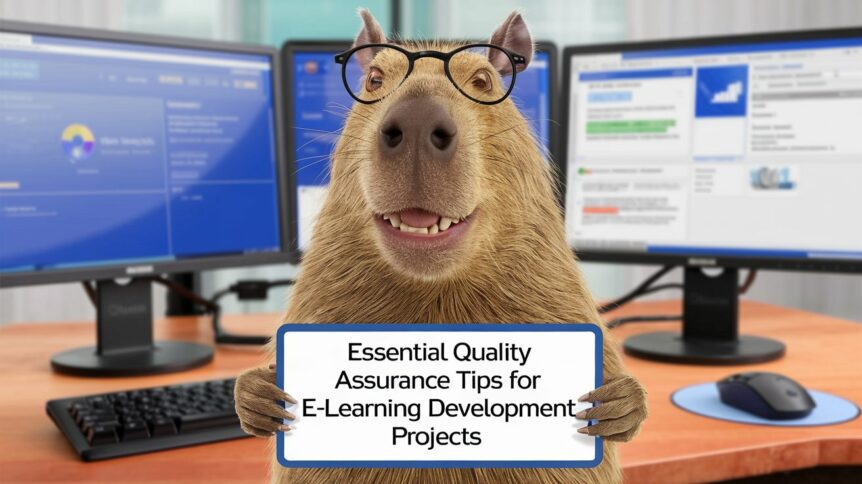10 Essential Quality Assurance Tips for E-Learning Development Projects
E-learning courses can be complex and detailed, with various functions, content types, and usability features. This makes quality assurance (QA) an essential part of the e-learning development process.
Without an effective QA process, learners can become frustrated not only with the course in question but your overall training strategy. Errors might give learners the wrong information, plus the course can fail in achieving its objectives.
The following 10 tips will help optimise the QA process in your e-learning development projects.
Use an Iterative Approach to Course Design
Creating an e-learning course and then doing QA is not an efficient way to identify and correct errors and issues. The best approach is for the QA process to begin at the very start of the development process. QA should then continue throughout, with each iteration checked and re-checked as you go. You should then conduct final checks and reviews, but this part of the process will be much easier if you have been checking as you go.
Make Sure Checks and Reviews Are Thorough
There are a lot of elements in an e-learning course, and they should all be checked as part of your QA processes. This includes:
- Text – spelling, punctuation, accuracy, etc
- Graphics – appearance, text accuracy, branding alignment, etc
- Video – accuracy of visuals, resolution quality, subtitles, buffering issues, etc
- Audio – content accuracy, volume levels, audio quality, etc
- Navigation – links, buttons, menus, etc
- Information – instructions, help tips, guidance, etc
Use a Checklist
Following on from the previous point, a checklist can ensure your checks and reviews are as thorough as possible. This is especially important when you bring other people into the reviewing process as a checklist will give them direction and prompts.
Conduct a User Flow Analysis
Put yourself in the shoes of a learner to get a feel for the user flow. Does it make sense? Is it clear what the learner should do next? Are the instructions and guidance sufficient? Is the navigation clear?
Get Fresh Input
Get other people to review, read, and test the e-learning course, preferably people who have not been involved in the development so they can give you a completely fresh perspective. There are two specific groups of people you should include in this part of the process (see below), but it is also beneficial to have others completely unconnected with the course to help with QA checks.
Get SMEs to Check
SMEs (subject matter experts) are typically involved in e-learning development projects in the early content planning stages. They should also be brought in as part of QA to ensure the content that is ultimately created is accurate and complete. SMEs may also be able to give helpful feedback in other areas, such as user flow and concept presentation.
Establish a Focus Group
In addition to general reviewers and SMEs, it is helpful to establish a small focus group comprising learners in the target audience as well as their managers and other key stakeholders. A focus group can help with identifying bugs and faults before the course is distributed more widely. You can also learn more about the quality of the course and its effectiveness in achieving the desired learning objectives.
Ensure There is An Effective Feedback Loop
A QA process is only as good as its feedback loop. In other words, it is not enough that problems and issues are found. They also have to be understood, assessed, and, where appropriate, corrected. So, make it easy for learners and other testers to report bugs and provide suggestions.
Take Action on Feedback and Bug Reports Quickly
Taking fast action when you get feedback or fault reports makes it easier to manage the process as tasks won’t be mounting up. It also shows those involved in the QA process that their efforts are valued.
Importantly though, taking action doesn’t necessarily mean doing what has been suggested. It means understanding the problem or suggestion, evaluating it, making a decision on what to do next, and then following through on that decision. In some cases, the decision will be to do either nothing or something different from the suggestion.
Conduct an Intended Use Assessment
When considering QA in e-learning development projects, it is possible to learn from other industries where QA is even more important. One of those industries is the medical device industry where QA can be a matter of life or death. The medical device industry uses the phrase “intended use”. This means the QA process doesn’t just check if the product works or not but also that it works as originally intended.
Translating this concept to an e-learning development project, you should assess whether the course that has been created delivers on the learning objectives and will achieve the desired business outcomes. In other words, it is not enough to have a nice, bug-free, and fully functional e-learning course. The course also has to deliver on its intended use.
Give QA the Attention It Deserves
QA in e-learning development should not be an afterthought or something that is crammed into the final stages of the project. By following the tips and best practices above, you will give QA the attention it deserves.
